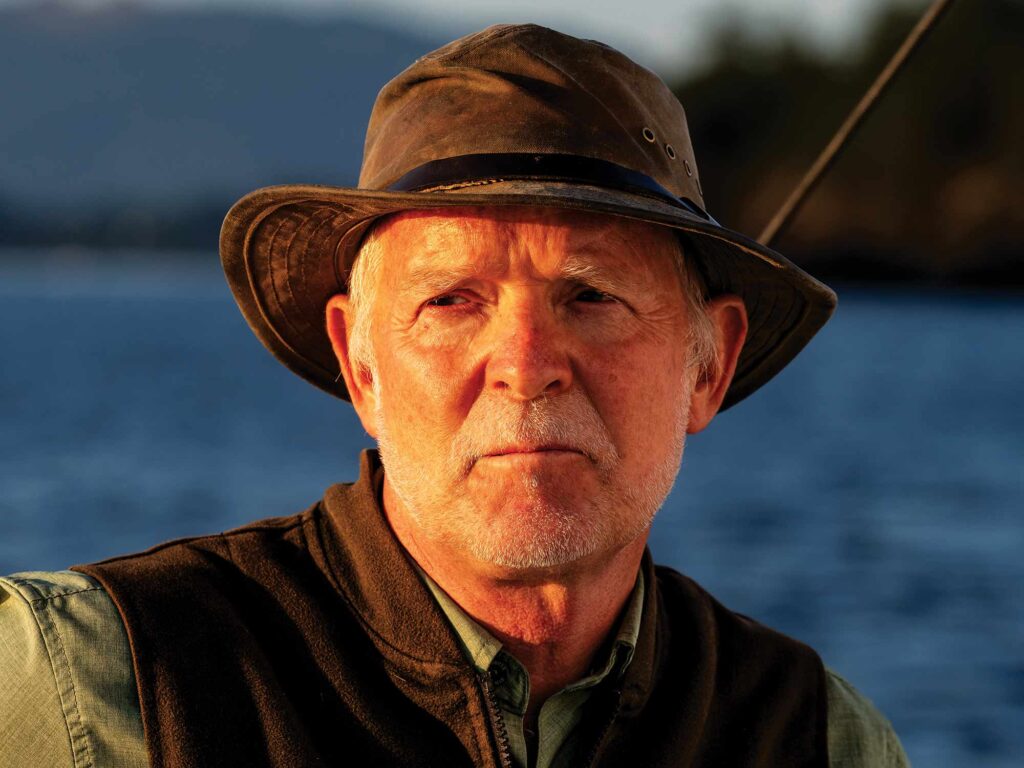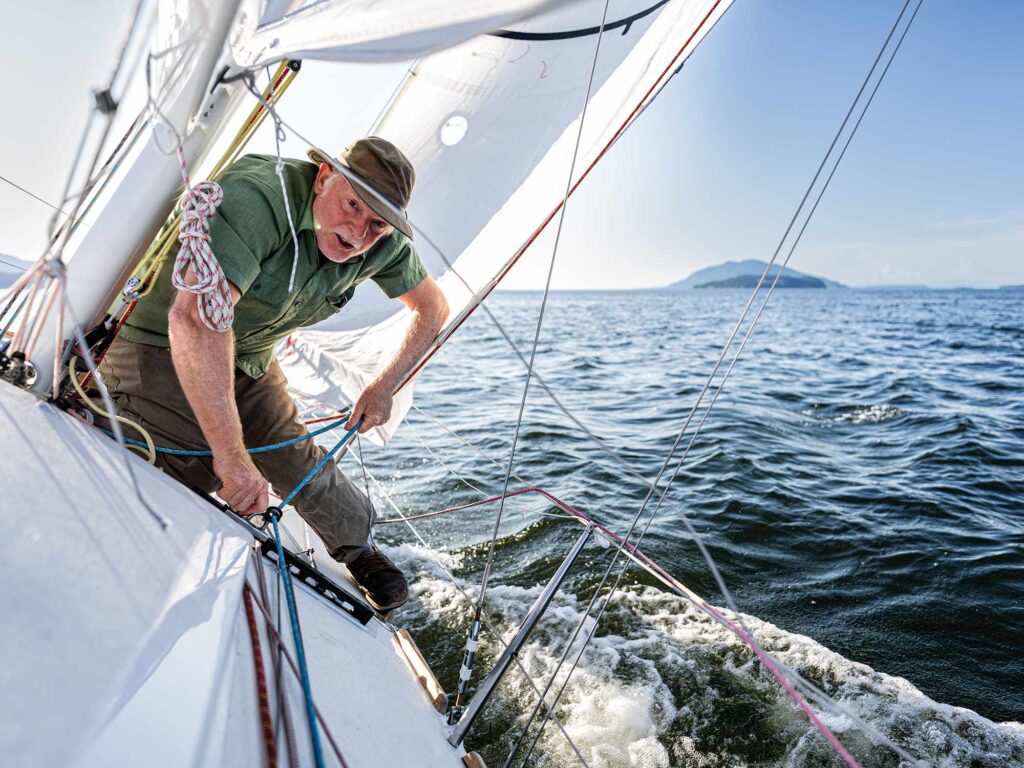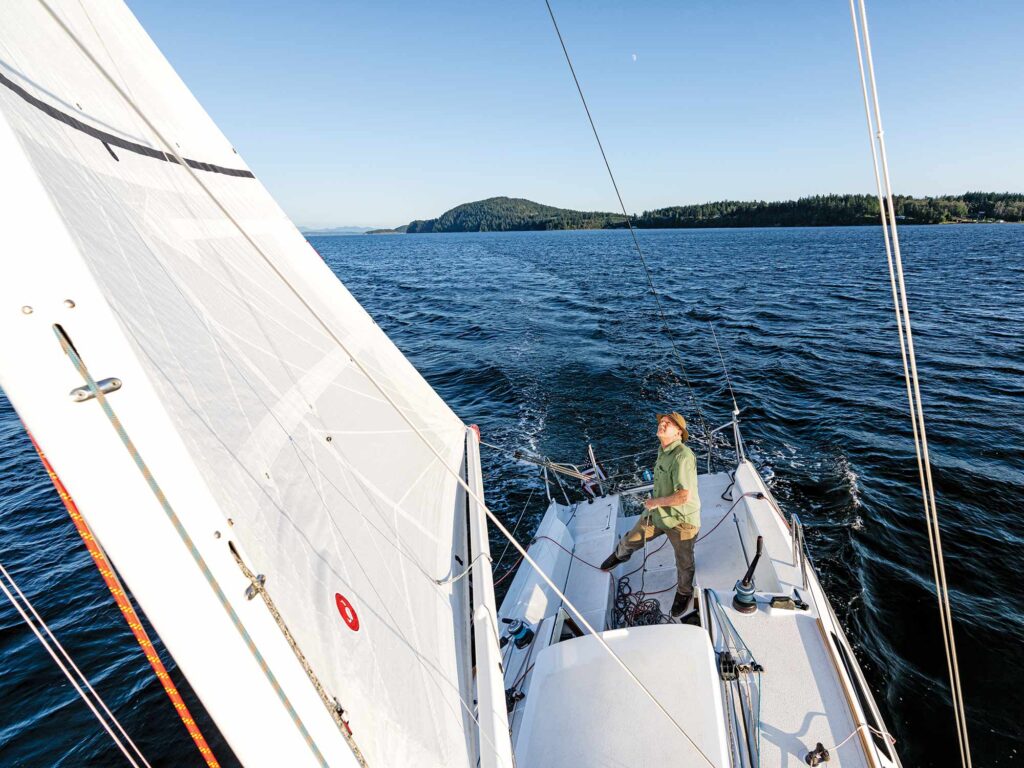
Rain needles Ketchikan’s harbor as Paul Bieker assesses the damage to one of his beloved designs. Dark Star, Jonathan and Libby McKee’s Riptide 44, just won the 2022 Race to Alaska, but McKee and crew found a log at 18 knots. I’d texted Bieker the photos, and he’d just arrived with a plan and his son, Leo. Minutes later, they begin sanding, layering on epoxy, mating, adding more epoxy, then resanding, skipping lunch and disregarding the on-off precipitation. Nothing about the scene suggests the presence of a two-time America’s Cup-winning naval architect. “It’s not beautiful,” Bieker says that evening, “but it’ll keep water from hydraulically separating the layers of carbon if we’re going fast.” Fourteen hours later, we depart for Seattle by way of Vancouver Island’s west coast.
In the world of high-performance sailing, few names are more synonymous with speed than Bieker’s, yet few Cup-winning designers have kept a lower, more grounded profile. This is by choice, and it suits; flannel shirts, wool sweaters and foredeck-battered fleece often define Bieker’s attire. Look past the Pacific Northwest camouflage, however, and one discovers that Bieker’s mind relentlessly drills on design and engineering problems. Coloring him the smartest guy in the room—while accurate—is lazy writing; his mind doesn’t stop seeking until he wrestles down his solution. Other naval architects may have seen more boats launched than Bieker, now 60, but few have created boats that are still setting racecourse records decades ex post facto.
It started with a car accident.
Bieker was born in Portland, Oregon, in October 1962. He’s the oldest of three kids born to a father who had a penchant for fast cars. This ended in (circa) 1968, when Fred Bieker rolled the family’s Mustang with his family aboard. Bieker’s mother suggested that her husband pursue a safer hobby.
He chose sailing.

Paul Bieker made his first tacks when he was 5 or 6 years old, and has amassed tens of thousands of miles since then. This began with trips up and down the West Coast with his family aboard their keelboats—first a Coronada 25, then an Erickson 35, then a Standfast 40—for races and cruises. As a result, Bieker became obsessed with sailing and with boats. “Before we’d go on a cruise, my mom would get me a 500-sheet ream of typing paper, and I’d sit down there and just draw boat after boat,” he says of his 11-year-old self. “It was a little nutty.”
By the early 1980s, Fred Bieker had upgraded to a Swan NYYC 48. In 1980, the Biekers sailed from Portland to San Francisco, then on to the Marquesas, the Tuamotus, the Society Islands, Rarotonga, Christmas Island, Hawaii and then home. For Paul, this year-and-a-half-long journey introduced him to Polynesian culture. He temporarily jumped ship and joined two German cruisers for a leg that involved sailing through a hurricane near Mururoa, where they were boarded by a French frigate.
“It was super memorable for a lot of reasons,” he says. “It was just great to spend that much time on boats—you really get a feel for what it’s like to live on one.”
Despite his love of yacht design, this didn’t feel like a practical profession. Come college, he enrolled in the Rhode Island School of Design’s architecture program. However, a middegree epiphany made him reconsider his path. In 1987, he graduated with high honors from the University of California at Berkeley with a degree in naval architecture.
Bieker first worked for Bay Area designer Gary Mull, but the fit wasn’t right—the shop was analog. “He wasn’t using any [computer-design] tools,” Bieker says. “PCs had just come out while I was in college,” he adds, noting that his studies included writing lines-fairing code. “It felt like that was where the future was.”
Swapping boards, Bieker took a full-time position as a commercial naval architect with Guido Perla & Associates in Seattle in 1988. Aside from providing steady work, Perla had written some sophisticated code for CNC-cutting steel plates, and the firm was using state-of-the-art design and lofting tools. This gig lasted two years, and Bieker learned career-defining skills. “I applied those techniques to yachts,” he says. “I’m pretty sure I was one of the first guys to use computer-aided construction at that level in the yachting world.”
Thirty-six hours into our delivery, I awake to a joyous smell. Bieker mans Dark Star’s single working burner and stirs 2 pounds of morels into a frying pan sizzling with olive oil, garlic and onions. A block of Parmesan cheese that he brought home from Sardinia—a perk of working part time for Luna Rossa during the 2024 Cup—sits nearby.
While decadent, these aren’t some pricey farmers-market fungi; Bieker foraged the morels himself—high in Washington’s North Cascade Mountains—just for this meal.
We soon tuck in. It’s hands-down the best dinner I’ve ever had at sea. Bieker just smiles, happy to gift his shipmates with some Pacific Northwest bounty.
Moths seek flames, and Bieker gravitated to Seattle’s Shilshole Marina after moving to town. He found the local International 14 fleet and was soon racing, designing and building these development-class skiffs.
“We built two boats and got first and second in the 1991 US Nationals,” he says. People wanted boats built to this design, but Perla didn’t allow moonlighting. “So, I went out and got a part-time naval architecture job and worked half-time building Fourteens,” he says, explaining that this is where he started learning about high-end composites. “That was an experience that I don’t think many designers get because you’re sailing the boat, designing the boat and building the boat. It’s experiencing the full circle of the process all inside one head.”
It also exposed him to working half-time while reserving bandwidth for his own designs. “It’s more interesting that way,” he says.
Nights and weekends found him designing a 21-footer, dubbed The Red Boat, using the computer-aided patterning skills he’d learned in the commercial marine world. While Bieker admits that it’s a stretch to call the triple-trapeze rocket ship a keelboat, his next commission was for a 55-foot performance-minded offshore cruiser. Rocket Science was one of the first commercial projects designed using CAD modeling software to computer-cut parts, and its innovation list included water ballasting, twin rudders, a deck-stepped carbon rig with swept spreaders and running backstays, a masthead asymmetric spinnaker and retractable centerline sprit pole, and hard chines.
Remember, this was 1994.
The next keelboat call came from his friend and Olympic gold medalist Jonathan McKee (a longtime Sailing World racing editor), who wanted an offshore-worthy racer-cruiser that could achieve high percentages of its polars with a doublehanded crew. The resulting two boats, dubbed Riptide 35s, each carry 1,750 square feet of off-the-wind cloth and displace just 4,700 pounds.
Impressive metrics, given that both boats sport cruising interiors.
Both Riptide 35s entered the 1998 Pacific Cup, with McKee and three shipmates racing aboard his Ripple while Bieker raced with three others aboard Terremoto!. The results remain the stuff of Seattle sailing lore: Ripple won its class, Terremoto! took second, and the two Riptides beat all of their classmates—including a Schumacher 46, a Santa Cruz 52 and an Andrews 56—across the line, save for one optimized Santa Cruz 50.

Decades later, Bieker still describes this as one of his best offshore experiences. Better still, both boats are still sailing, and Terremoto! set a course record during the 2023 Swiftsure Race. “Watching the original Riptide 35 still being fast—what, 30 years later? That’s pretty satisfying,” he says.
Next, Bieker began developing a new International 14 rudder that situated the hydrofoils higher on the rudder stock. The goal, he says, was “to make the waves think the boat is longer.”
It worked. Kris Bundy and Jamie Hanseler beat 115 other teams at the 2000 International 14 Worlds. “That’s probably one of the brighter things I’ve done,” Bieker says of the foils. “It was worth about 100 yards in a first weather leg.”
This didn’t go unnoticed. “The America’s Cup work that I got was directly related to my first foray into hydrofoils on the Fourteen,” Bieker says, explaining that Bill Erkelens, Oracle Racing’s CEO for the 2003 America’s Cup, was a former Fourteen sailor. Erkelens was seeking a design liaison between Oracle’s sailing and design teams, but Bieker knew that working with structures would be a better fit. “Between my social skills and my knowledge of America’s Cup politics, I figured there was no way I’d survive in that job,” he says. “I had this combination of knowing the [composite] materials, knowing how the materials handle, and having an engineering background.”
He was hired part time for Oracle’s next two unsuccessful campaigns. While not an auspicious start, Bieker experienced two cycles of Cup design and witnessed boatbuilding’s highest standards.
I’m doing a lousy job of keeping the kite filled without oversteering. Pacific Northwest fog shrouds our horizons, some 40 nautical miles northwest of Vancouver Island’s Brooks Peninsula, white-rooming all visual references. Worse, the choppy seas are incongruent with the breeze, which—for me—is a little thin to keep Dark Star rumbling.
I hear stirrings belowdecks, and Bieker emerges. He’s (rightly) not impressed with my driving; I happily relinquish the helm and watch.
Bieker leverages his skiff skills, and Dark Star responds by settling into a VMG-pleasing rhythm I couldn’t play: The kite fills, the bow lifts, and the compass card freezes.
When asked about some of his proudest engineering feats, Bieker points to the system that BMW Oracle innovated for the 2010 Cup for raising and lowering the wingsail on their 90-foot trimaran and to the boat’s foils. “That was a pretty big jump in how foils are built,” he says.
BMW Oracle swept Alinghi 2-0 in 2010’s Deed-of-Gift match on the waters off Valencia, Spain, and the newly crowned Defender began drafting the Protocol for the 2013 Cup. The new AC72s were a big advance, but some technologies were transferable. “The [foils on the] AC72s were just an elaboration of what we did on the big trimaran, but more refined,” Bieker says.
While the Defender almost always has an edge in the Cup, ETNZ was the first to foil their AC72, and come the Cup’s start, theirs was the fastest horse. BMW Oracle found themselves looking at the wrong side of an 8-1 match-point scoreboard deficient, but rather than imploding, the team came alive. This started at press conferences and continued through all-night design-and-build sessions aimed at finding extra speed. It worked, and the team pulled off one of the greatest come-from-behind wins in sports history. “There were a lot of reasons why we beat them,” Bieker says. “One of them was having better foils.”
The trimarans were swapped for even faster cats (AC50s) for the 2017 Cup, and Bieker was named lead design engineer for Oracle. This full-time position required that he and his wife and two sons relocate to Bermuda for two years, but it allowed him to be heavily involved in creating the AC50 class’s one-design hull shapes and rigs, and later with the design of the Defender’s race boat.
Unfortunately for Oracle, ETNZ introduced “cyclors” to the sailing lexicon and beat the Defender 7-1. The Auld Mug went to Auckland, and Bieker took a Cup hiatus. However, this coincided with the launch of SailGP, which employs “F50s” (read: modified AC50s), and he kept innovating the design. Now, almost a decade after their conception, F50s remain the world’s fastest multihulls.
This break from AC work also allowed him to pursue more diverse projects, including keelboats, Moths, and even some powerboats. This latter list includes designing the electric-powered and hydrofoil-borne Navier 27, and reengineering the composite lifting foils for a low-wake passenger ferry.
In 2020, Bieker and the Seattle naval architecture firm Glosten joined forces to create a zero-emission foiling ferry. “It can transport people over water using one-third of the energy [of] the next best thing,” he says. “You don’t get the opportunity to make those kinds of improvements that often.”
I join Bieker on deck at 0200 for my last night watch of the delivery. We’re near Port Angeles, on the American side of the Strait of Juan de Fuca, in the kind of thin wind and negative water that parks up most monohulls, yet we’re still making 5 knots.
This is wonderful; we’re almost out of fuel.
Bieker grips a coffee mug, and we joke about how lucky we got—following seas, downwind angles, almost zero rain—on this gentleman’s delivery, which is now almost complete. “This one could have gone either way,” he says, recalling other trips down Vancouver Island’s desolate west coast. Once, he says, during a Van Isle 360 International Yacht Race, Dark Star blew out a portlight while slugging into heavy seas off the Brooks Peninsula and started onboarding enormous volumes of seawater.
He’s too modest to mention it, but I know from McKee that Bieker solved the problem using a hard foam bumper, rope, a ratchet and quick-but-careful thinking.
“I think I’ve laid some pretty good performance boats down in my own little way,” Bieker says. To date, roughly 30 Bieker Boats have been constructed, and he views them all as his intellectual offspring. “Every new boat that you design and build should be trying to push the art forward. It should feel like the world is a little bit of a better place with that boat.”
While Bieker acknowledges that other naval architects have built more boats, he also admits that he’s allergic to repetition. “It’s a more time-consuming and expensive way to work—to re-create the wheel each time—but it means you learn.”
This is evident at Bieker Boats’ offices in Anacortes, Washington, where Bieker works with his business partner, Eric Jolly, and designer, Evan Walker. Massive monitors display projects being created using the latest computational-design tools; the shelves are populated with exquisite one-off carbon-fiber bits from various campaigns.
“I don’t advertise,” he says. “My dad always said, ‘You get the work you deserve,’ so all of my work has been word of mouth. That way, you get good clients.”
When queried about what his dream project would be at this stage of his career, Bieker envisions a career circumnavigation. “It would be to design a performance cruiser,” he says. “That 55 was my first shot at that kind of boat, and it would be fun to do more.”
Given that Bieker and McKee describe Dark Star—a 44-foot carbon-fiber build that weighs 10,300 pounds—as a cruiser-racer, this sure wouldn’t be some bloated dock condo. It could very well have a foil or two, and will most certainly look different than every other boat in the marina.









